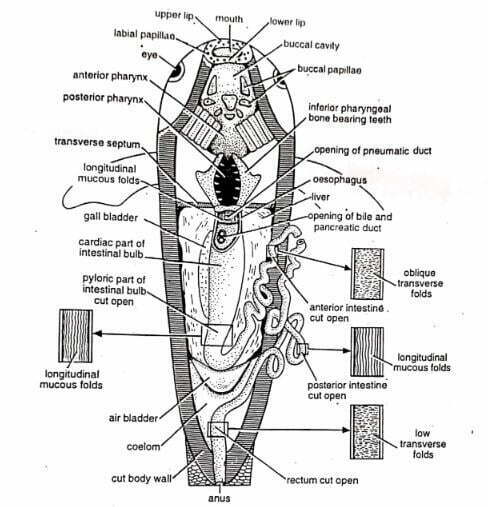In this article about Labeo rohita, we will learn about the digestive system of Labeo rohita or Rohu. Labeo rohita is a bony fish under the class Osteichthyes. It is a native fish to South and South East Asia. Its common name is Rohu, Rui, etc.
Systematic Position of Rohu
| Kingdom: | Animalia |
| Phylum: | Chordata |
| Class: | Actinopterygii |
| Order: | Cypriniformes |
| Family: | Cyprinidae |
| Genus: | Labeo |
| Species: | Labeo rohita |
What is The Digestive System?
The digestive system is a physiological system by which the animal converts complex food into absorbable simple food in order to keep active its body functions.
Digestive System of Labeo rohita
The whole digestive system of Labeo rohita is divided into two parts. 1. Alimentary canal or digestive tract, and 2. Digestive glands.

1. Alimentary Canal
- The alimentary canal of the Labeo rohita is complete.
- It starts from the mouth and ends at the anus.
- The alimentary canal consists of the mouth, buccal cavity, pharynx, oesophagus, intestinal bulb, intestine, rectum, and anus.
a) Mouth
- The alimentary canal starts from the mouth.
- It is a sub-terminal crescentic slit.
- It is bounded by upper and lower lips.
- The lips are fleshy.
- The lips contain four or five rows of conical papillae which contain taste buds.
b) Buccal Cavity
- The mouth leads into the buccal cavity.
- It is broad and dorso-ventrally compressed.
- Teeth and tongue are absent in the buccal cavity.
- The floor of the buccal cavity contains thick muscles.
- The mucous membrane lining the buccal cavity bears minute papillae.
c) Pharynx
- The buccal cavity leads into the pharynx.
- It is dorso-ventrally compressed.
- It is bounded by gill arches laterally.
- The pharynx is divided into two parts. The anterior part of the pharynx is the respiratory part and the posterior part of the pharynx is the masticatory part.
- The anterior respiratory part is perforated laterally by 4 pairs of gill slits.
- Small and spiny gill rakers prevent the passage of food through gill slits.
- The posterior masticatory part bears 3 rows of homodont pharyngeal teeth.
- Each tooth has a narrow basal root and a conical crown for crushing and grinding food.
d) Oesophagus
- The pharynx leads into the tubular ooesophagus.
- It is a short and narrow tube.
- Its mucous lining forms prominent longitudinal folds.
- A pneumatic duct named “ductus pneumaticus” from the air bladder of fish opens to the oesophagus in the dorsal region.
e) Intestinal Bulb
- Labeo rohita lacks a true stomach.
- The intestinal bulb works like the stomach.
- It is the anterior part of the intestine which becomes swollen to form a sac-like body. This sac-like part is called the intestinal bulb.
- The oesophagus opens into it.
- Food is stored in the intestinal bulb.
- The oesophageal opening into the intestinal bulb is guarded by an oesophageal valve.
- The oesophageal valve prevents the regurgitation of digested food.
- The intestinal bulb lacks gastric glands.
- The mucosa of the intestinal bulb contains absorptive and mucous cells.
- The intestinal bulb is divided into two parts. The anterior broader part is the cardiac part and the posterior narrow part is the pyloric part.
- The pancreatic and bile ducts open into the anterior cardiac part.
f) Intestine
- The intestinal bulb opens into the intestine.
- It is a thin-walled, narrow and elongated tube.
- It is a much-coiled tube.
- As Labeo rohita is a herbivorous fish, its intestine is longer than that of carnivorous fish.
- Labeo rohita lacks pyloric caeca, intestinal villi and scroll valva.
g) Rectum
- The intestine leads into the rectum.
- Its mucosal lining shows distinct oblique transverse folds.
- The rectum stores the faecal matter temporarily.
h) Anus
- The rectum leads into the anus.
- It is the ending part of the alimentary canal.
- It is located just in front of the anal fin.
- Faecal matter is expelled out through the anus.
2. Digestive Glands
The digestive glands of Labeo rohita are the liver and the pancreas. They help in the digestion of food. They are an important part of the digestive system of Labeo rohita.
a) Liver

Fig: Digestive gland of Labeo rohita (Liver).
- It is a large gland and dark brown in color.
- It is bilobed which means it has two lobes. Right and left lobes.
- The right liver lobe is narrower than the left liver lobe.
- Both lobes are interconnected in three regions. They are anterior, median and posterior regions.
- A gall bladder is present which is an elongated sac.
- It is located between the right lover lobe and the intestinal bulb.
- A cystic duct arises from the gall bladder.
- A cystic duct and three hepatic ducts from the liver lobes unite and open to the cardiac part of the intestinal bulb.
b) Pancreas
- It is a diffused structure.
- It is found among the coils of the intestine.
- The pancreatic duct opens into the cardiac part of the intestinal bulb.
———————THE END——————–
Read more:
- Urinogenital System of Labeo rohita | Rohu | Diagram
- Respiratory System of Labeo rohita with Diagram | Rohu
- External Morphology of Labeo rohita | Rohu | Diagram
- Labeo rohita – Rohu / Rui
- General Characters of All Classes of Vertebrates.
Reference:

Md Ekram Hossain Bhuiyan is a passionate student currently pursuing his studies at Jagannath University in Dhaka. He is a zoology major and his love for animals, nature, and wildlife is evident in his academic pursuits. Ekram is a curious and adventurous individual who always seeks to learn more about the world around him. His passion for animals began at a young age, and he has since dedicated himself to studying the behavior, anatomy, and habitats of various species.
He finds peace in being surrounded by the beauty of nature and observing the creatures that call it home. He believes that it is important to protect and preserve the natural world for future generations.
As a student of zoology, Ekram is dedicated to expanding his knowledge of the subject. He is a hardworking individual who strives for excellence in his studies and is always eager to take on new challenges. Ekram is a driven and compassionate individual who is dedicated to his studies and his passion for animals, nature, and wildlife.